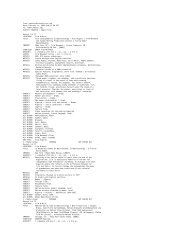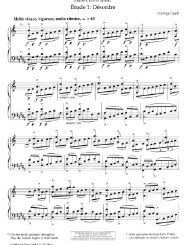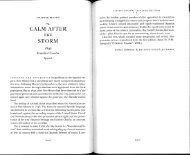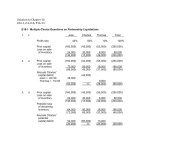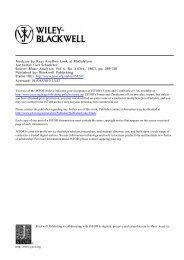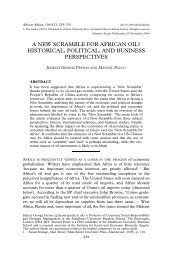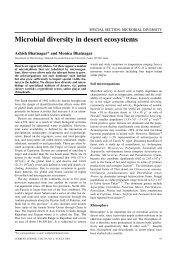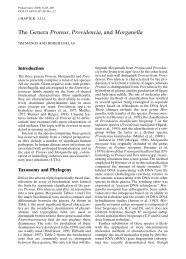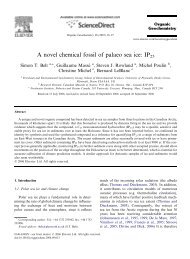The Genus Serratia
The Genus Serratia
The Genus Serratia
Create successful ePaper yourself
Turn your PDF publications into a flip-book with our unique Google optimized e-Paper software.
CHAPTER 3.3.11 <strong>The</strong> <strong>Genus</strong> <strong>Serratia</strong> 225<br />
noninfected patients, and separation of their<br />
respective nurses).<br />
Model 4: Colonization of the newborn intestinal<br />
tract. Typically, an investigation of a case of<br />
<strong>Serratia</strong> infection leads to the discovery that<br />
most newborns are colonized by a red-pigmented,<br />
drug-susceptible strain of S. marcescens.<br />
A common source can be identified (“sterile”<br />
water or oily antiseptic solution used to clean the<br />
baby’s skin). Contamination may occur on the<br />
first day of life. Multiplication of the strain in<br />
soiled diapers may show a red discoloration (reddiaper<br />
syndrome). Control of this situation is<br />
sometimes difficult due to the size of the reservoir.<br />
Newly sterilized solutions are quickly contaminated<br />
again. Enforcement of handwashing<br />
and frequent sterilization (daily or more) of<br />
incriminated solutions may be helpful.<br />
Model 5: Pseudoepidemics. A drug-sensitive<br />
strain of any <strong>Serratia</strong> species (e.g., S. liquefaciens)<br />
is unreproducibly isolated from several patients<br />
who show no sign of infection. Investigation of<br />
the plastic material used to “sterilely” collect<br />
blood occasionally allows the isolation of the<br />
environmental strain that contaminated the<br />
system (plastic tubing, EDTA, or citrate<br />
solution).<br />
<strong>The</strong> above situations are sometimes mixed or<br />
less clear. References to reports fitting with the<br />
above models can be found in Farmer et al., 1976;<br />
Schaberg et al., 1976; von Graevenitz, 1977, 1980;<br />
and Daschner, 1980.<br />
Properties Relevant to Pathogenicity<br />
in Humans<br />
<strong>Serratia</strong> marcescens is generally an opportunistic<br />
pathogen causing infections in immunocompromised<br />
patients. Among the possible pathogenicity<br />
factors found in <strong>Serratia</strong> strains are the<br />
formation of fimbriae, the production of potent<br />
siderophores, the presence of cell wall antigens,<br />
the ability to resist to the bactericidal action of<br />
serum, and the production of proteases.<br />
In practice, each strain of the genus <strong>Serratia</strong><br />
produces one to three different kinds of fimbrial<br />
hemagglutinin (HA) (Old et al., 1983). Five<br />
types of fimbriae have been observed in<br />
serratiae:<br />
Type 1 fimbriae: thick, channelled fimbriae of<br />
external diameter 8 nm, associated with a mannose-sensitive<br />
hemagglutinin (MS-HA) reacting<br />
strongly with untanned fowl or guinea pig erythrocytes.<br />
<strong>The</strong> production of MS-HA is increased<br />
by serial, static broth cultures in air at either 20,<br />
30, or 37°C. Production of MS-HA was found to<br />
be correlated with the ability of S. marcescens<br />
cells to attach to human buccal epithelial cells<br />
(Ismail and Som, 1982) or to the human urinary<br />
bladder surface (Yamamoto et al., 1985). This<br />
type of HA was found to be produced by all (Old<br />
et al., 1983) or almost all (Franczek et al., 1986)<br />
S. marcescens strains, whether environmental or<br />
clinical, and in some strains of other <strong>Serratia</strong> species,<br />
except S. plymuthica and S. fonticola.<br />
Type 3 fimbriae: thin, non-channelled fimbriae<br />
of external diameter 4–5 nm associated with a<br />
mannose-resistant hemagglutinin reacting with<br />
tannic acid-treated, but not fresh, oxen erythrocytes<br />
(MR/K-HA) (Old et al., 1983). MR/K-HA<br />
was found to be produced by almost all strains<br />
of all <strong>Serratia</strong> species studied by Old et al. 1983.<br />
However, Franczek et al. 1986 found MR/K-HA<br />
was more frequently produced by clinical than<br />
by environmental strains of S. marcescens. <strong>The</strong><br />
MR/K-HA of all <strong>Serratia</strong> species, except S.<br />
rubidaea, were immunologically related. MR/K-<br />
HA from S. rubidaea was immunologically<br />
related to a Klebsiella MR/K-HA (Old et al.,<br />
1983).<br />
Thin fimbriae associated with a mannose-resistant<br />
hemagglutinin reacting with fowl, guinea<br />
pig, and horse erythrocytes (type FGH MR/P-<br />
HA). This HA was produced by strains from all<br />
species except S. plymuthica, S. odorifera, and S.<br />
fonticola (Old et al., 1983). <strong>The</strong> corresponding<br />
fimbriae are immunologically related in the different<br />
species.<br />
Thin fimbriae associated with a mannoseresistant<br />
hemagglutinin reacting with fowl erythrocytes<br />
only (type F MR/P-HA). This HA was<br />
produced by some S. rubidaea strains and was<br />
immunologically unrelated to other hemagglutinins<br />
(Old et al., 1983).<br />
Thick, channelled fimbriae of external diameter<br />
9–10 nm: associated with a mannose-resistant<br />
hemagglutinin reacting with fowl erythrocytes<br />
only (type F MR/P-HA). This HA was produced<br />
by some S. fonticola strains (Old et al., 1983).<br />
Nearly all clinical or environmental S. marcescens<br />
strains produce potent siderophore(s)<br />
capable of scavenging iron from ethylenediamine<br />
di-O-hydroxyphenylacetic acid, a chelator<br />
with an association constant for ferric iron of<br />
10 33.9 (Franczek et al., 1986). <strong>Serratia</strong> strains (S.<br />
marcescens and S. liquefaciens were tested) generally<br />
produce enterobactin (Reissbrodt and<br />
Rabsch, 1988) but only rarely produce aerobactin<br />
(Martinez et al., 1987). A novel iron (III)<br />
transport system named SFU, was evidenced in<br />
a S. marcescens strain. In this system, no siderophore<br />
production is involved (Zimmermann et<br />
al., 1989).<br />
At least two patterns of hemolysis were found<br />
to be produced by S. marcescens on horse blood:<br />
a clear-cut narrow zone of hemolysis under<br />
the colony, evoking the action of a cell-bound<br />
hemolysin, and a fuzzier, diffusing zone of<br />
hemolysis evoking the production of a soluble<br />
hemolysin (Grimont and Grimont, 1978b). <strong>The</strong>



